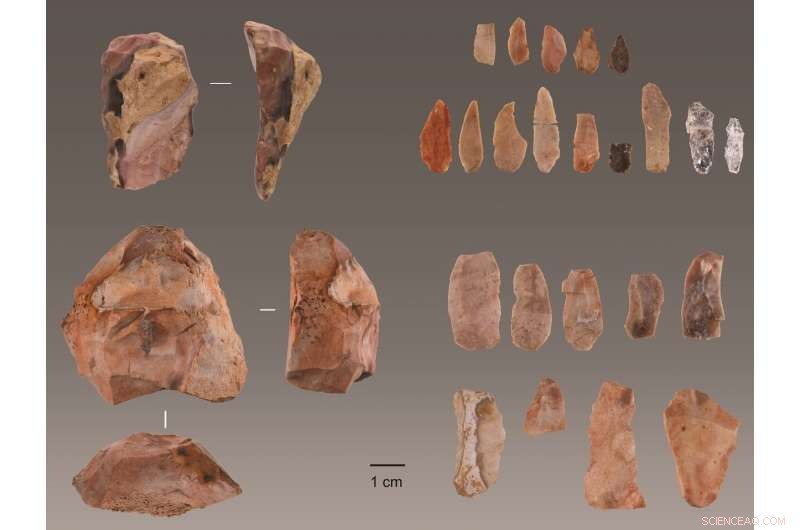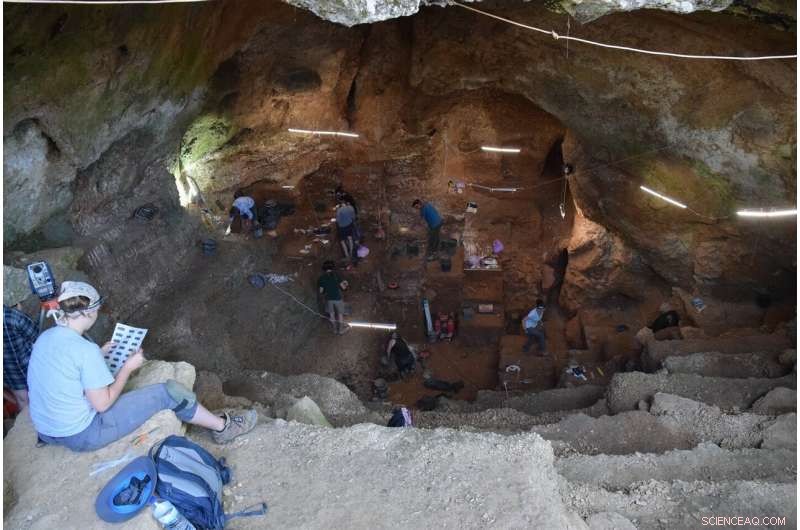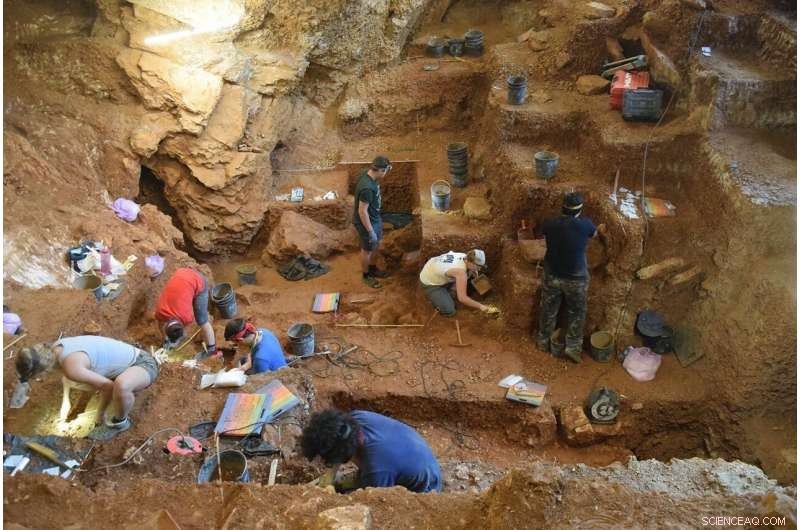
Verktyg upptäckts i Lapa do Picareiro i centrala Portugal. Kredit:Jonathan Haws.
Moderna människor anlände till den västligaste delen av Europa 41, 000—38, 000 år sedan, ca 5, 000 år tidigare än tidigare känt, enligt Jonathan Haws, Ph.D., professor och ordförande för institutionen för antropologi vid University of Louisville, och ett internationellt team av forskare. Teamet har avslöjat upptäckten av stenverktyg som används av moderna människor daterade till den tidigare tidsperioden i en rapport som publicerades denna vecka i tidskriften Proceedings of the National Academy of Sciences .
Verktygen, upptäcktes i en grotta som heter Lapa do Picareiro, ligger nära Atlantkusten i centrala Portugal, länka platsen med liknande fynd från hela Eurasien till den ryska slätten. Upptäckten stöder en snabb spridning västerut av moderna människor över Eurasien inom några tusen år efter deras första uppträdande i sydöstra Europa. Verktygen dokumenterar närvaron av moderna människor i västra Europa vid en tidpunkt då neandertalare tidigare troddes vara närvarande i regionen. Fyndet har viktiga konsekvenser för att förstå den möjliga interaktionen mellan de två mänskliga grupperna och neandertalarnas slutliga försvinnande.
"Frågan om de sista överlevande neandertalarna i Europa har ersatts eller assimilerats av inkommande moderna människor är en långvarig, olöst problem inom paleoantropologi, sa Lukas Friedl, en antropolog vid University of West Bohemia i Pilsen, Tjeckien, och projektledare. "De tidiga datumen för Aurignacian-stenverktyg vid Picareiro utesluter sannolikt möjligheten att moderna människor anlände till landet som länge saknat neandertalare, och det i sig är spännande."
Tills nu, de äldsta bevisen för moderna människor söder om floden Ebro i Spanien kom från Bajondillo, en grottplats på södra kusten. Upptäckten av stenpallar karakteriserad som Aurignacian, teknologi förknippad med tidigmoderna människor i Europa, i ett säkert stratigrafiskt sammanhang vid Picareiro ge definitiva bevis på tidig modern mänsklig ankomst.
"Bajondillo erbjöd lockande men kontroversiella bevis för att moderna människor var i området tidigare än vi trodde, " Sa Haws. "Bevisen i vår rapport stöder definitivt Bajondillos implikationer för en tidig modern mänsklig ankomst, men det är fortfarande inte klart hur de kom hit. Människor vandrade troligen längs öst-västflytande floder i det inre, men en kustväg är fortfarande möjlig."
"Utbredningen av anatomiskt moderna människor över Europa för många tusen år sedan är central för vår förståelse av var vi kom ifrån som en nu global art, sa John Yellen, programchef för arkeologi och arkeometri vid National Science Foundation, som stödde arbetet. "Denna upptäckt erbjuder betydande nya bevis som kommer att hjälpa till att forma framtida forskning som undersöker när och var anatomiskt moderna människor anlände till Europa och vilka interaktioner de kan ha haft med neandertalare."

Utsikt över Lapa do Picareiro från entrén. Kredit:Jonathan Haws
Picareiro-grottan har varit under utgrävning i 25 år och har producerat ett register över mänsklig ockupation under de senaste 50, 000 år. Ett internationellt forskarlag från Interdisciplinary Center for Archaeology and Evolution of Human Behavior (ICArEHB) i Faro, Portugal, undersöker ankomsten av moderna människor och utrotningen av neandertalare i regionen.
Projektet leds av Haws, Michael Benedetti från University of North Carolina Wilmington, och Friedl, i samarbete med Nuno Bicho och João Cascalheira vid universitetet i Algarve, där ICArEHB är inrymt, och Telmo Pereira från det autonoma universitetet i Lissabon.
Med stöd från U.S. National Science Foundation-anslag till Haws och Benedetti, teamet har avslöjat rika arkeologiska fyndigheter som inkluderar stenverktyg i samband med tusentals djurben från jakt, slakt- och matlagningsverksamhet.
Sahra Talamo vid universitetet i Bologna, Italien, och Max Planck Institute for Evolutionary Anthropology i Leipzig, Tyskland, gick med i forskargruppen för att fastställa åldern för de tidiga moderna människorna och neandertalarnas yrken. She used state-of-the-art bone pretreatment and accelerator mass spectrometry (AMS) to date the bones that show evidence of butchery cut marks and intentional breakage by humans to extract bone marrow, a highly prized and nutritious food consumed by ancient people. The dating results place the modern human arrival to the interval between 41, 000 and 38, 000 år sedan. The last Neanderthal occupation at the site took place between 45, 000 and 42, 000 år sedan.
"The radiocarbon results from Lapa do Picareiro are not only very precise in terms of the dating method, but also demonstrate the meticulous work of the archeologists at the site, " Talamo said. "The importance of collaboration between the radiocarbon specialist and the archaeologists is essential in order to obtain an accurate chronology like in the case of Picareiro."
Spatial analysis of high-resolution three-dimensional data confirmed the precise stratigraphic relationships between artifacts and radiocarbon samples and revealed discrete layers of occupation at the site.
"Analysis of high-resolution spatial data is crucial for documenting and observing lenses of human occupation and reconstructing occupational patterns, especially in cave environments where complex formation processes exist, " said Grace Ellis, en Ph.D. student at Colorado State University studying landscape archaeology and ancient settlement patterns.

View of the excavation of the early modern human (foreground) and Neanderthal layers (background) of Lapa do Picareiro. Credit:Jonathan Haws
This was backed up by artifact refitting that showed the stone tools were not moved through post-depositional processes.
"Refitting is a task that requires a lot of time and patience, and in this case, it really was worthwhile because the results verified the geospatial observations, " said Pereira, an archaeologist who specializes in stone technology.
While the dates suggest that modern humans arrived after Neanderthals disappeared, a nearby cave, Oliveira, has evidence for Neanderthals' survival until 37, 000 år sedan. The two groups may have overlapped for several thousand years in the area.
"If the two groups overlapped for some time in the highlands of Atlantic Portugal, they may have maintained contacts between each other and exchanged not only technology and tools, but also mates. This could possibly explain why many Europeans have Neanderthal genes, " said Bicho, director of ICArEHB.
"Besides genetic and archeological evidence, high-resolution temporal context and fossil evidence across the continent is crucial for answering this question. With the preserved key layers dated to the transitional period, we are now awaiting human fossils to tell us more about the nature of the transition, " Friedl said.
Despite the overlap in dates, there does not appear to be any evidence for direct contact between Neanderthals and modern humans. Neanderthals continued to use the same stone tools they had before modern humans arrived, bringing a completely different stone technology.
"Differences between the stone tool assemblages dated before and after about 41, 000 years ago are striking at Picareiro, " said Cascalheira, an ICArEHB board member and specialist on stone tool technology. "Older levels are dominated by quartzite and quartz raw materials and marked by the presence of Levallois technology, a typical element of Neanderthal occupations in Europe. Aurignacian levels, å andra sidan, are dominated by flint and the production of very small blades that were likely used as inserts in arrow shafts for hunting."
Flint also was used to make tools for butchering animals such as red deer, ibex and possibly rabbits. The team recovered a few red deer canine teeth, often used as personal adornments, but so far these do not show traces of manufacturing jewelry.
"The bones from Lapa do Picareiro make up one of the largest Paleolithic assemblages in Portugal, and the preservation of these animal bones is remarkable, " said Milena Carvalho, en Ph.D. candidate at the University of New Mexico and ICArEHB researcher studying the diets and paleoecology of Neanderthals and modern humans. "The collection will provide tremendous amounts of information on human behavior and paleoecology during the Paleolithic and we will be studying it for decades."
The cave sediments also contain a well-preserved paleoclimatic record that helps reconstruct environmental conditions at the time of the last Neanderthals and arrival of modern humans.
"We studied changes in the size of limestone clasts and the chemistry of muddy fine sediment filling the cave to understand the paleoclimatic context for the transition, " Benedetti said. "Our analysis shows that the arrival of modern humans corresponds with, or slightly predates, a bitterly cold and extremely dry phase. Harsh environmental conditions during this period posed challenges that both modern human and Neanderthal populations had to contend with."
The cave itself has an enormous amount of sediment remaining for future work and the excavation still hasn't reached the bottom.
"I've been excavating at Picareiro for 25 years and just when you start to think it might be done giving up its secrets, a new surprise gets unearthed, " Haws said. "Every few years something remarkable turns up and we keep digging."